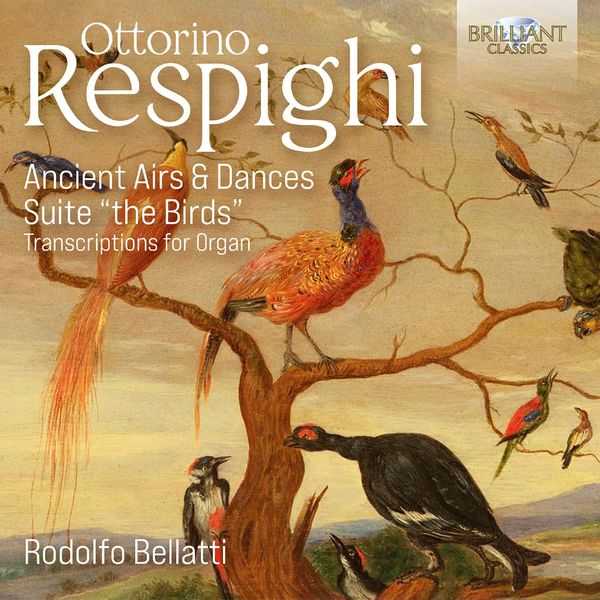
Composer: Ottorino Respighi
Performer: Rodolfo Bellatti
Format: FLAC (tracks)
Label: Brilliant
Catalogue: 96221
Release: 2022
Size: 357 MB
Recovery: +3%
Scan: yes
01. Balletto detto “il conte Orlando” (Ballet called “Earl Orlando”) Simone Molinaro [1599]
02. Villanella (Peasant Girl) Unknown [End. XVI Century]
03. Gagliarda (Charming Girl) Vincenzo Galilei [155.]
04. Italiana (Italian Girl) Unknown [End. XVI Century]
05. Passacaglia (Passacaglia) Lodovico Roncalli [1692]
06. Siciliana (Sicilian Girl) Unknown [End XVI Century]
07. Laura Soave (Pretty Laura) Fabrizio Carosio [1531…]
08. Bergamasca (Dance from Bergamo) Bernardo Gianoncelli Known as Il Bernardello [1650]
09. Arie di corte (Court Arias) Giovanni Battista Besardo [Sec.XVI]
10. Danza rustica (Country ballet) Giovanni Battista Besardo [1617]
11. Campanae Parisienses – Aria (Paris’ bells – Aria) Unknown [1600] / Marsenne Marin [1636]
12. Passo mezzo e mascherada (Passo mezzo and masquerade) Unknown [End XVI century]
Gli Uccelli The Birds – Suite (1928) – Organ Version by Rodolfo Bellatti
13. I. Preludio (Prelude) [from B.Pasquini, 1637-1710]
14. II. La Colomba (The Dove) [from J.Gallot, 1670]
15. III. La Gallina (The Hen) [from Ph. Rameau, 1683-1768]
16. IV. L’Usignuolo (The Nightingale) [from an English Anonymous of the XVII century]
17. V. Il Cucù (The Cuckoo) [from B.Pasquini, 1637-1710]
Though not strictly born in the 1880s (1879), Respighi belonged to a group of composers known as the “generazione dell’ottanta” (the 80s generation), who strived to assert, as they saw it, a renewed musical expression of authentically Italian musical culture. It was a conservative stance in terms of both musical approach and nationalism, but it resulted in Respighi and colleagues recovering unjustly neglected treasures from their Italian heritage. Respighi’s first international success, an arrangement of Monteverdi’s Lamento d’Arianna, may be seen as the natural forerunner to the four suites of arrangements and transcriptions on this album.
While the intent may have been conservative, Respighi’s approach to what we now call “early music” was notably liberal by our standards, marked as much by nostalgia and irony as erudition. Orchestration is much too weak a term to do justice to the process of subtle recomposition to which Respighi subjected his chosen originals.
Suite No. 1 of the Ancient Airs & Dances consists of four pieces, yet Rodolfo Bellatti has moved its concluding Passo mezzo e Mascherada to the very end of the three suites in order to bring an authentically lively and upbeat close to the sequence as a whole. Many critics have singled out the Third Suite as the finest, perhaps because of its melancholy and reflective character.
Between composing the Second and Third of these Suites, Respighi produced another small masterpiece of affectionate neoclassicism with his Gli Uccelli. Five avian-themed pieces of harpsichord and lute music supply Respighi with his originals, to which he gives a stylized gloss.
Rodolfo Bellatti has made these Respighi transcriptions while bearing in mind their suitability for organs of different ages, styles and sizes. He has aimed to respect both the colours and form of Respighi’s suites as well as the nature of the original pieces with their older tuning systems and affective idiom. He has also chosen to confine himself to the range of pitches afforded by organs of the 16th and 17th centuries. The result is spectacular and presented on this new recording, which is recorded on the magnificent Serassi and Grisanti Organs at the Cathedral of Santa Maria Assunta, Asti, Italy, the specifications of which are included in the booklet.